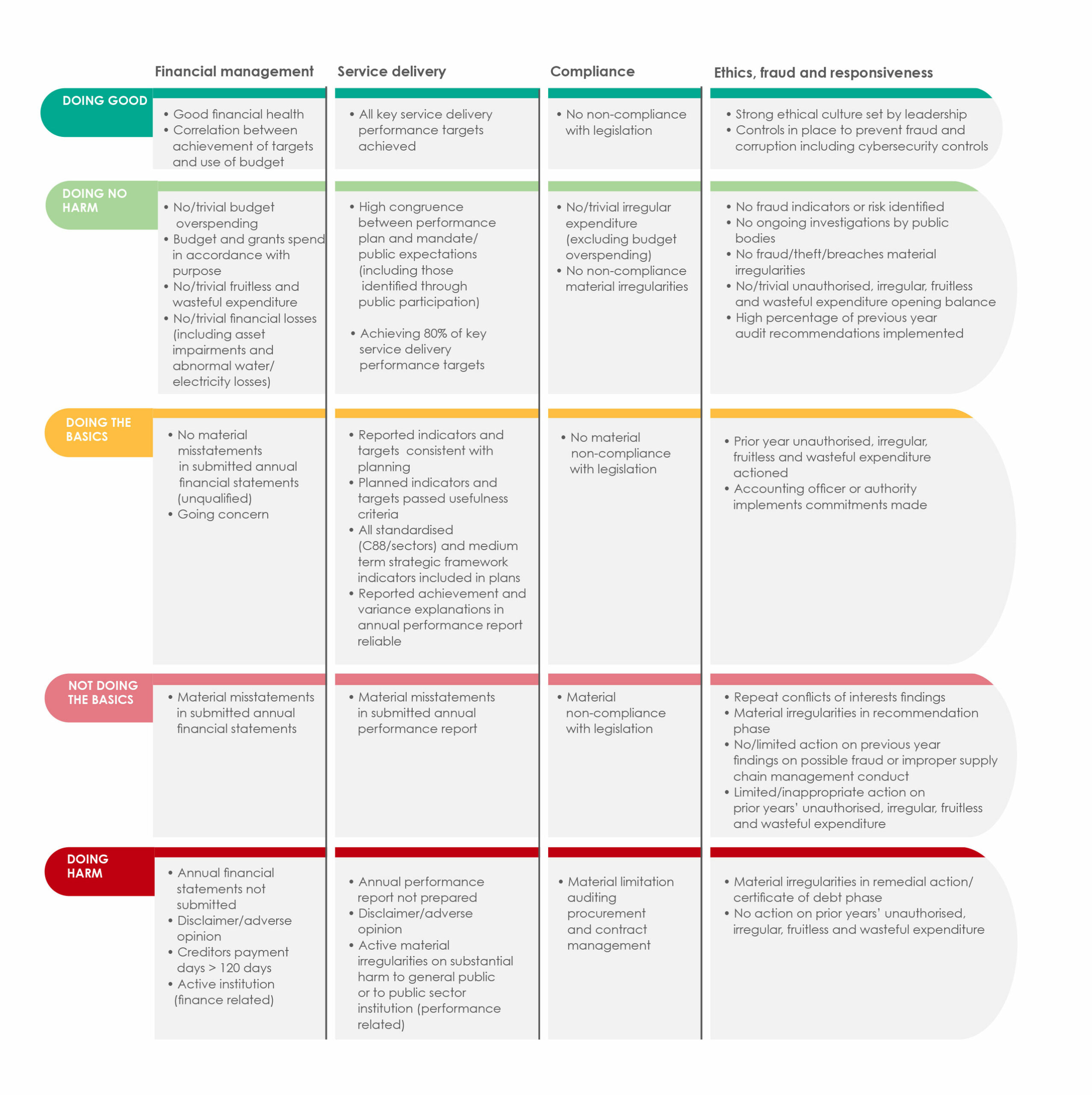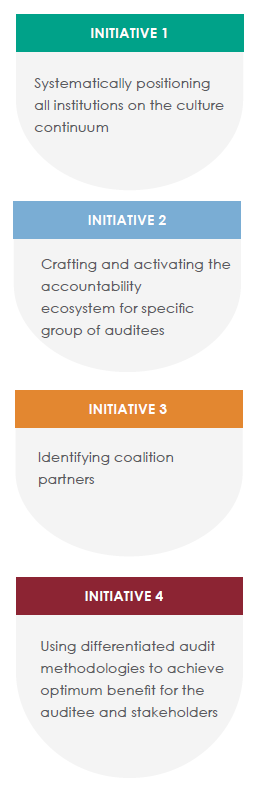If the public service is to deliver on its part of the constitutional promise, it must embrace a culture of performance, accountability, transparency and integrity. It is not until such a culture is entrenched within the public service that we will begin to see consistent, meaningful and sustained improvements in audit outcomes.
Shifting public sector culture requires us to enhance our effectiveness at pulling the appropriate levers within the scope of our mandate and resources. At the same time, we seek to forge and strengthen partnerships with, and exercise our influence on, stakeholders with the scope, mandates and resources to pull other levers in a manner that complements our efforts.
Establishing the existing cultures in our auditees’ environments
During this period, we worked to establish the status quo, i.e. categorising the culture of our auditees based on well-defined, consistently applied indicators. We sought to reach a shared understanding of the definitions of performance, accountability, transparency and integrity
These definitions will guide our assessment of the status of public sector institutions, determine the focus of our work to provide insight and apply the right level of enforcement, engage our stakeholders in the accountability ecosystem, and inform the way in which we express ourselves in our reports.
We also established the measurement principles, developed detailed plotting criteria based on our definitions and categorised them into four cardinal areas.
Categorising the public sector
The categories of public sector culture form a culture shift continuum that spans from doing harm to doing good.
These criteria for there categories are summarised as follows:

We classified 422 institutions (228 institutions in national and provincial government and 194 in local government), which included metropolitan municipalities, municipal entities, coordinating institutions, and departments and public entities that play a significant role in a number of value chains. These were plotted against the approved criteria.
422 government institutions plotted

None of the institutions that we plotted managed to fall in the category of “doing good” and none of the local government auditees managed to achieve even a “doing no harm” rating. This sets the bar high, which is firmly consistent with our message that a shift in culture to performance, accountability, transparency and integrity is urgently required.
This is a tough starting position, given our ultimate vision for the success of our strategy: a minimum of 30% of institutions that we audit shifting to “doing good” by 2030, with less than 10% in the “doing harm” category.
Culture shift charter
We developed the culture shift charter as a tactical approach to driving at least 30% of the public sector institutions that we audit towards a meaningful and observable shift to “doing good” by 2030.
This mapping exercise is the first of its kind and we will continue fine-tuning our understanding and concepts as we implement our strategy. Engagement with the public sector institutions is paramount to creating individual, customised programmes for improving their unique cultures. Plotting and progress along the culture shift continuum will be included in the 2023-24 management reports.
The charter brings together cohesive and complementary strategic initiatives, outlines the levers for each strategic goal, and highlights the changes in our own organisational mindset required to enable a culture shift.
The culture shift charter was designed to be implemented in the 2023-24 financial year, with further development and enhancements in subsequent years. For the 2022-23 cycle, we identified the insight, influence and enforcement levers for deployment in targeted value chains, metropolitan municipalities, intermediate cities, and among the disclaimer and clean audit clusters in local government.
Since a one-size-fits-all approach is not effective in changing public sector culture, our audit teams are customising the levers for each public sector institution, based on their indepth knowledge of the institution’s environment, to ensure optimum impact.
The charter provides a detailed list of the levers; however, a few examples are presented below:
The key strategic initiatives outlined in the charter include:

Insight:
We produced an integrated annual audit plan for the 2022-23 cycle to guide scoping, messaging, resources and tools for our audit planning, execution and reporting.
Influence:
We developed the public sector landscape to identify key roleplayers in government. This will assist us to direct our accountability messages to relevant stakeholders.
Enforcement:
We defined the concept of a high-impact material irregularity and developed principles to support our auditors in identifying impactful material irregularities. This was added to the material irregularity manual.
For the 2023-24 financial year, we expect to get buy-in and commitment from public sector institutions on walking the journey with us, to shift from where they are plotted to where they need to be. We will also develop and implement institution-specific action plans that detail the specific levers that need to be deployed for that institution, giving due consideration to the principles in the culture charter.
Conclusion
For the first time we have defined our understanding of the categories of public sector culture around the four aspects of performance, transparency, accountability and integrity. We have completed our detailed initial plotting of institutions that we audit from selected sectors and value chains.
We realise that the low starting point for the majority of our auditees may present a challenge to the achievement of our vision for the performance of the public sector.
We appreciate the clarity around such a starting point, as it clarifies programmes that we need to implement to not only support and encourage our auditees to move up the culture shift continuum but also to provide the necessary support to other roleplayers in the accountability ecosystem.
Plotting on the culture shift continuum is an iterative process. We will therefore schedule regular checkpoints to refine the defined criteria, to develop adequate processes and guidance for embedding the culture shift continuum concept. Individual plotting results will be discussed with each institution to allow them to create plans for improvement.

